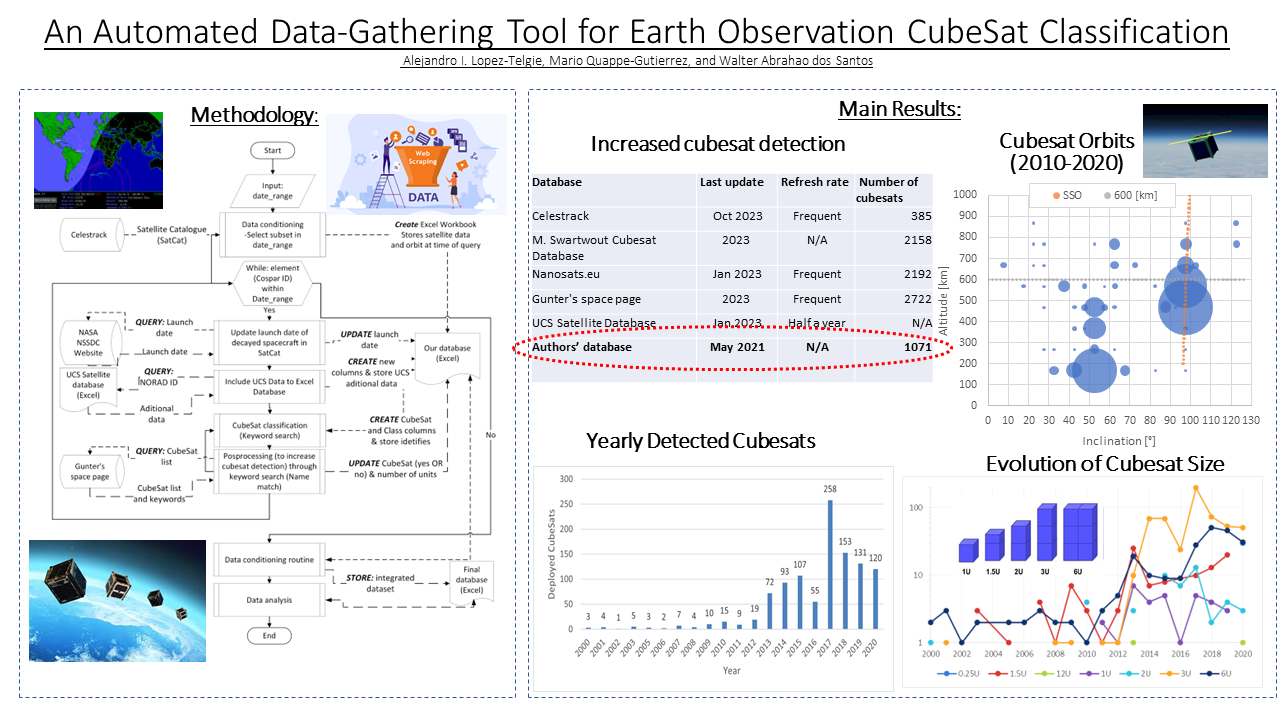An Automated Data-Gathering Tool for Earth Observation CubeSats Classification
Keywords:
Cubesat, Small satellites, nanosatellite, earth observationAbstract
This study presents an automated tool designed for the classification and analysis of Earth Observation CubeSats, with focus in the low Earth orbit (LEO) region (200-1,000 km altitude). Leveraging an integration of data from different reputable databases, the tool provides a detailed data repository which facilitates analysis of CubeSat deployment trends, configurations, and operational orbits, aiding in mission design. A key finding from our analysis is the pronounced concentration of CubeSats in certain LEO regions: Sun-Synchronus and ISS, with the United States as a leading contributor in CubeSat deployments. Moreover, the tool offers a comprehensive estimation of lifecycle costs associated with CubeSat missions, highlighting a trend of decreasing costs among major CubeSat developers such as Planet and Spire. This cost reduction trend is attributed to economies of scale, implementation of ground segment infrastructure, and vertical integration in the development of the satellites. By providing a detailed dataset, and classification of CubeSats, along with an analysis of cost trends, this research contributes valuable insights for the planning and cost optimization of future space missions. The findings underscore the growing commercial viability and strategic importance of CubeSats in the evolving landscape of Earth observation and new space.
Downloads
References
J. Puig-Suari, C. Turner, and W. Ahlgren, “Development of the standard CubeSat deployer and a CubeSat class PicoSatellite,” in 2001 IEEE Aerospace Conference Proceedings (Cat. No.01TH8542), 2001, vol. 1, pp. 1/347-1/353.
E. Kulu, “FP7 NANOSAT database,” 2022. [Online]. Available: http://www.nanosats.eu/. [Accessed: 12-Apr-2022].
eoPortal Directory, “Satellite Missions Database,” 2023. [Online]. Available: https://directory.eoportal.org/ web/eoportal/satellite-missions. [Accessed: 12-Oct-2023].
T. S. Kelso, “CelesTrak,” 2023. [Online]. Available: https://celestrak.org/. [Accessed: 05-Mar-2023].
G. D. Krebs, “Gunter’s Space Page,” 2023. [Online]. Available: https://space.skyrocket.de/. [Accessed: 18-Oct-2023].
E. Kulu, “Satellite Constellations - NewSpace Index,” 2023. [Online]. Available: https://www.newspace.im/. [Accessed: 21-Mar-2023].
M. Swartwout, “CubeSat Database - Swartwout,” 2020. [Online]. Available: https://sites.google.com/a/slu.edu/swartwout/home/cubesat-database. [Accessed: 17-Jul-2020].
UCS, “Union of Concerned Scientists (UCS) Satellite Database - Updated Jan 1, 2021,” 2021. [Online]. Available: https://www.ucsusa.org/nuclear-weapons/space-weapons/satellite-database. [Accessed: 20-Apr-2021].
Bryce Space and Technology, “Smallsats by the Numbers 2019,” 2019.
Bryce, “Smallsats by the Numbers 2020,” 2020.
NASA S3VI, “State-of-the-Art of Small Spacecraft Technology | NASA,” 2022. [Online]. Available: https://www.nasa.gov/smallsat-institute/sst-soa. [Accessed: 21-Mar-2023].
SpaceWorks, “2020 Nano/Microsatellite Market Forecast, 10th Edition,” 2020.
J. Bouwmeester and J. Guo, “Survey of worldwide pico- and nanosatellite missions, distributions and subsystem technology,” Acta Astronaut., vol. 67, no. 7–8, pp. 854–862, Oct. 2010.
D. Selva and D. Krejci, “A survey and assessment of the capabilities of Cubesats for Earth observation,” Acta Astronaut., vol. 74, pp. 50–68, May 2012.
M. Swartwout, “The first one hundred CubeSats : A statistical look,” J. Small Satell., vol. 2, no. 2, pp. 213–233, 2013.
A. Poghosyan and A. Golkar, “CubeSat evolution: Analyzing CubeSat capabilities for conducting science missions,” Prog. Aerosp. Sci., vol. 88, pp. 59–83, Jan. 2017.
T. Wekerle, J. B. Pessoa Filho, L. E. V. L. da Costa, and L. G. Trabasso, “Status and Trends of Smallsats and their Launch Vehicles — An Up-to-date Review,” J. Aerosp. Technol. Manag., vol. 9, no. 3, pp. 269–286, Aug. 2017.
T. Villela, C. A. Costa, A. M. Brandão, F. T. Bueno, and R. Leonardi, “Towards the Thousandth CubeSat: A Statistical Overview,” Int. J. Aerosp. Eng., vol. 2019, pp. 1–13, Jan. 2019.
F. L. de Sousa, “Are smallsats taking over bigsats for land Earth observation?,” Acta Astronaut., vol. 213, no. July, pp. 455–463, 2023.
H. C. Polat, J. Virgili-Llop, and M. Romano, “Survey, Statistical Analysis and Classifica-tion of Launched CubeSat Missions with Emphasis on the Attitude Control Method,” JoSS, vol. 5, no. 3, pp. 513–530, 2016.
NASA GSFC, “NSSDCA Master Catalog,” 2022. [Online]. Available: https://nssdc.gsfc.nasa.gov/nmc/SpacecraftQuery.jsp. [Accessed: 08-Mar-2023].
S. Nag, J. LeMoigne, and O. de Weck, “Cost and risk analysis of small satellite constellations for earth observation,” in 2014 IEEE Aerospace Conference, 2014, pp. 1–16.
J. Le Moigne, J. C. Adams, and S. Nag, “A New Taxonomy for Distributed Spacecraft Missions,” IEEE J. Sel. Top. Appl. Earth Obs. Remote Sens., vol. 13, pp. 872–883, 2020.
M. Greenberg, “System Integration Schedule Estimating Relationships (SERs),” in NASA Cost and Schedule Symposium, 2019.
NASA, NASA SP-2016-6105 Systems Engineering Handbook Revision 2. 2017.
International Academy of Astronautics (IAA), “Definition and Requirements of Small Satellites Seeking Low - Cost and Fast - Delivery,” 2017.
J. Mrozinski, M. Saing, M. Hooke, A. Lumnah, and J. Johnson, “COMPACT KNN: Developing an Analogy-Based Cost Estimation Model for CubeSats Jet Propulsion Laboratory, California Institute of Technology Pasadena, CA 91109,” in 2020 IEEE Aerospace Conference, 2020, pp. 1–9.
M. Hooke, “COMPACT KNN V2: Analogy-Based Cost Estimation Model for CubeSats,” IEEE Aerosp. Conf. Proc., vol. 2022-March, pp. 1–9, 2022.
J. Mrozinski, “k-NN and Parametric Cost Modeling for CubeSats,” in 2019 NASA Cost and Schedule Symposium, 2019.
Crunchbase, “Planet - Funding, Financials, Valuation & Investors.” [Online]. Available: https://www.crunchbase.com/organization/planet-labs/company_financials. [Accessed: 18-Aug-2020].
Crunchbase, “Spire Global - Crunchbase Company Profile & Funding.” [Online]. Available: https://www.crunchbase.com/organization/spire. [Accessed: 18-Aug-2020].
P. G. Buzzi, D. Selva, N. Hitomi, and W. J. Blackwell, “Assessment of constellation designs for earth observation: Application to the TROPICS mission,” Acta Astronaut., vol. 161, no. November 2018, pp. 166–182, 2019.
Spaceflight Industries, “Pricing - Spaceflight,” 2022. [Online]. Available: https://spaceflight.com/pricing/. [Accessed: 06-Jul-2022].
SPIRE, “The Low Earth Multi-Use Receiver (LEMUR),” 2022. [Online]. Available: https://spire.com/spirepedia/low-earth-multi-use-receiver/. [Accessed: 11-Oct-2022].


